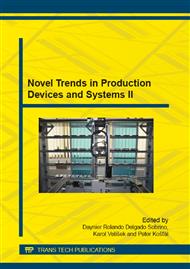[1]
J. Boss, Solid mixing process (in Polish), PWN, Warszawa – Wrocław, (1987).
Google Scholar
[2]
G.V. Barbosa-Cánovas, E. Ortega-Rivas, P. Juliano, H. Yan, Food Powders Physical Properties, Processing and Functionality, Springer-Verlag, New York, (2005).
Google Scholar
[3]
R. Choldrich, Fundamentals of particle technology, Midland Information Technology and Publishing, Loughborough, (2002).
Google Scholar
[4]
F. Stręk, Mixing and mixers (in Polish), Wydawnictwa Naukowo-Techniczne, Warszawa, (1981).
Google Scholar
[5]
R. Hogg, Mixing and Segregation in Powders: Evaluation, Mechanisms and Processes, KONA Powder and Particle Journal. 27 (2009) 3-17.
DOI: 10.14356/kona.2009005
Google Scholar
[6]
L. Obregón, A. Realpe, C. Rinaldi, C. Velázquez, Mixing of granular materials. Part I: Effect of periodic shear, Powder Technology 197 (2010) 9–16.
DOI: 10.1016/j.powtec.2009.08.014
Google Scholar
[7]
J.B. Królczyk, A. Latawiec, M. Kuboń, Sustainable Agriculture – the Potential to Increase Wheat and Rapeseed Yields in Poland, Pol. J. Environ. Stud. Vol. 23, No. 3 (2014), 11-20.
Google Scholar
[8]
G. Krolczyk, P. Nieslony, S. Legutko, Microhardness and Surface Integrity in Turning Process of Duplex Stainless Steel (DSS) for Different Cutting Conditions, Journal of Materials Engineering and Performance. 23, 3 (2014) 859-866.
DOI: 10.1007/s11665-013-0832-4
Google Scholar
[9]
G. M. Krolczyk, P. Nieslony, S. Legutko, Determination of tool life and research wear during duplex stainless steel turning. Archives of Civil and Mechanical Engineering (2014), http: /dx. doi. org/10. 1016/j. acme. 2014. 05. 001.
DOI: 10.1016/j.acme.2014.05.001
Google Scholar
[10]
G. Krolczyk, J. B. Krolczyk, S. Legutko, A. Hunjet, Effect of the disc processing technology on the vibration level of the chipper during operation, Tehnički vjesnik/Technical Gazette. Vol. 21 No. 2 (2014) 447-450.
Google Scholar
[11]
J. Krolczyk, Analysis of the amount of impurities received in the feed production process with recirculation of ingredients (in Polish), Inżynieria Rolnicza. 3(145) T. 1 (2013) 149-157.
Google Scholar
[12]
J. Krolczyk, An attempt to determine the influence of mixing time on the amount of impurities in compound feeds (in Polish), Inżynieria Rolnicza. 3(145) T. 1 (2013) 159-167.
Google Scholar
[13]
J. B. Krolczyk, An attempt to predict quality changes in a ten-component granular system, Tehnički vjesnik/Technical Gazette. Vol. 21 No. 2 (2014) 255-261.
Google Scholar
[14]
J. Królczyk, M. Tukiendorf, Research on the impact mass fractions of multi-element granular structure on the mixing process, International Agrophysics. 22 (2008) 45-52.
Google Scholar
[15]
J. Grochowicz, Manufacturing Technology of Feed Mixtures (in Polish), PWRiL, Warszawa, (1996).
Google Scholar
[16]
P. J. Cullen, Food Mixing: Principles and Applications, Hardcover, Wiley-Blackwell (2009).
Google Scholar
[17]
L. Obregón, A. Realpe, C. Rinaldi, C. Velázquez, Mixing of granular materials. Part I: Effect of periodic shear, Powder Technology, 197 (2010) 9-16.
DOI: 10.1016/j.powtec.2009.08.014
Google Scholar
[18]
G. Dryden, Animal nutrition science, Oxford University Press, Incorporated. (2008).
Google Scholar
[19]
G. Królczyk, J. Królczyk. Analysis of the stability problem of the worm agitator (in Polish), Inżynieria Rolnicza 2 (137), T. 2, (2012) 151-158.
Google Scholar
[20]
ISO 6869: 2000 Animal feeding stuffs - Determination of the contents of calcium, copper, iron, magnesium, manganese, potassium, sodium and zinc - Method using atomic absorption spectrometry.
DOI: 10.3403/02182786
Google Scholar
[21]
D. Eisenberg, Measuring mixer variation- performance and crosscontamination validation, 16th Annual ASA-IM SEA Feed Technology and Nutrition Workshop May 26-30, (2008).
Google Scholar
[22]
N. Barashkov, D. Eisenberg, S. Eisenberg, J. Mohnke, Ferromagnetic microtracers and their use in feed applications, XII International Feed Technology Symposium, Novi Sad, 13-16th November, (2007).
Google Scholar
[23]
Information on http: /www. microtracers. com/products/microgrits.
Google Scholar


